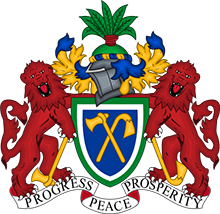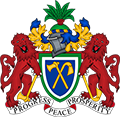“The Smiling Coast”
friendliness have made it “The Smiling Coast.” Tourism has become the fastest-growing sector of the economy, contributing 12% of the country’s GDP and providing employment for over
100,000 Gambians. More and more visitors are returning year after year.
A BIT OF HISTORY
The Gambia’s history is marked by almost as much cultural diversity as its current population. The first “tourists” were Portuguese traders in the 1500s who introduced peanuts and cotton
before leaving a hundred years later, selling their trading rights to the British. Fort James, established by the British, soon had a rival fort at Albreda, built by the French. During the 17th and 18th centuries, these forts were the scenes of periodic battles between the countries striving for control of regional trade. Britain gained all rights to trade in 1783, and administered the territory from Sierra Leone until 1888, when The Gambia became a crown colony, completely surrounded by French Senegal except for a small section of coastline. In the 1960s, federation with Senegal was considered, but finally in 1965 The Gambia became an independent country with Dawda Kairaba Jawara as first president. He retained power until the beginning of the Second Republic in 1994 under current-President Yahya Jammeh.
GEOGRAPHY AND CLIMATE
The Gambia is 180 miles long, but only 21 miles wide, and follows the course of the River Gambia as it meanders west through mangrove swamps, bamboo forests, and salt flats, to the
capital city Banjul, which is located along the 30-mile stretch of Atlantic coast. The Gambia lies at the southern edge of the Sahel and is made up of mostly savannah and open woodland
vegetation. The raining season is short, from July to September, with most of the precipitation falling at night. The climate is dry and warm from December through February, the peak of the tourist season.
THE PEOPLE
The Gambia’s population density of 92 people per square kilometres makes it the fourth most densely populated country in Africa. Eight different ethnic groups, the largest of which are the
Mandinkas, traditionally farmers, the Fulani, traditionally herders, and the Wollof, mainly traders, live peacefully together in The Gambia. Though each group speaks its own language,
English is commonly spoken and is the official language of the country .Not only is there no ethnic strife in The Gambia but there is increasing cultural interaction and intermarriage, making
the country a West African melting pot. The population is predominantly Muslim with more than 90% following Islam.
Arts and Culture The Gambia has a strong musical tradition, often associated with weddings, feast-days such as the end of Ramadan, or Christmas. Traditional instruments include the kora (lute ), bala (xylophone ), and the tama (hand-held drum). Though the majority of the population is Muslim, Christmas brings a celebration with large lanterns called fanals, often in the shape of boats or houses and intricately decorated. The fanals are paraded through the streets to singing and chanting.
How to Get There
Airlines from Europe have many scheduled flights to The Gambia, and Gambia Airways and Air Gambia have direct flights between London and Banjul. Air Afrique flies from New York to
Dakar. The Banjul International Airport is an ultra-modern point of welcome to The Gambia and serves as a major hub to and from other capitals throughout West Africa.
Citizens of Commonwealth countries, ECOW AS members, and certain European countries do not need a visa for travel to The Gambia but citizens of all other countries should apply at the
nearest consulate or mission. For American travellers, the Embassy of The Gambia is located at 1155 15th Street, N. W., Washington, D.C. 20005 (phone: 202.785.1399, fax: 202.
785.1430, www.gambia.com).
Once there, the Gambia Public Transport Corporation offers an extensive, low-cost public transit system with bus service linking all towns in the country. Taxis are readily available, and car
rental agencies offer unlimited mileage.
Quick Tourist Facts
What to bring: Binoculars, anti-malaria medication
Customs: No restrictions
languages Language: English, a number of African
Food: Traditional Gambian dishes include: domodah, peanut stew with rice; plasas, meat and fish with vegetable leaves; foufou, mashed cassava; and benechin, fish and rice
Clothes: Lightweight, modest dress to respect Muslim custom
Photography: Photographing military or government installations prohibited. Refrain from photographing Gambians to respect Muslim custom
Electricity: 220 volts (as in Europe).
Money: 1 dalasi = 100 bututs, $IUS -10.00D. Money-changing easily done
Phone service: International calls easily made. GAMTEL sells phonecards
Post office and mail: Reliable
US Embassy: Karaiba Avenue, Fajara. Phone: 49.28.56, fax: 49.24.75
Business hours: Monday-Thursday 8:30-12:30, 2:30-5:30, Friday-Saturday 8-12; Banks Monday-Friday 9-12,2-4 or 4-6
Safety: One of the safest countries in West Africa
Health care: Royal Victoria Hospital in Banjul. Hospital in Bansang (up country).
Immunizations: Yellow fever innoculation
Favorite Tourist Destinations
Banjul
The capital city is on the tip of a peninsula at the mouth of the River Gambia. The center of town is MacCarthy Square, a public park, with Albert Market to the east, and the deep water port with its wharves and jetties to the south. Because the city is locked on an island, the nearby towns of Bakau, Fajara and Serrakunde are rapidly expanding.
Visitors won’t want to miss Albert Market with its colours, smells, music, fabrics and crafts. Popular souvenirs include batik, gold and silver filigree jewelry, wood carvings and leather goods.
Tailors can quickly make clothes to order at reasonable prices. The National Museum of Gambia on Independence Drive houses wooden carvings, old maps and photos of the country. Arch 22, the city gate commemorating the Second Republic of the Gambia following the bloodless July 1994 coup, has a museum, cafe and great views of the area from the top. Day cruises through the mangrove creeks around Banjul are a popular excursion, with birds and monkeys to be spotted.
Visitors won’t want to Miss Albert Market with its colours, smells, music, fabrics and crafts. Popular souvenirs include batik, gold and silver filigree jewellery, woodcarvings and leather goods. Tailors can quickly make clothes to order at reasonable prices. The National Museum of Gambia on Independence Drive houses wooden carvings, old maps and photos of the country. Arch 22, the city gate commemorating the Second Republic of the Gambia following the bloodless July 1994 coup, has a museum, cafe and great views of the area from the top.
Day cruises through the mangrove creeks around Banjul are a popular excursion, with birds and monkeys to be spotted. Escaping the city, the visitor to The Gambia will discover the nearby Abuko Nature Reserve, only 15 miles from the city center on the way to the airport. The reserve was established in 1977 to help protect and preserve The Gambia’s flora and fauna for future generations. Open daily from 8-6, the reserve features diverse vegetation, 200 species of birds, monkeys, hyenas, antelope, hippos and crocodiles. Safaris can be arranged easily according to visitors’ interests.
Juffureh, Forts Albreda and James, Tendaba Camp
The setting for Alex Haley’s novel Roots, Juffureh is a traditional village, an easy trip from Banjul, and now a part of The Roots Homecoming Festival, an annual celebration of African heritage. This week-long festival features music, dance, workshops, excursions, and other activities designed to help visitors of African background discover their roots. At nearby Fort Albreda and Fort James, visitors can see many reminders of colonial history.
Tendaba Camp, 100 miles up-river from Banjul, was the country’s first inland hotel, constructed to replicate an African village with traditional huts. The camp is a good starting point for daytrips by boat, for bird-watching, or to visit the West Kiang National Park.
Wassu Stone Circles
These circles are believed to be ancient burial mounds dating back 1200 years. Each circle consists of 10-24 massive stones dotting the landscape in the largest such concentration in West Africa. They are located on the northern side of the river, about 20 miles northwest of Georgetown.
River Gambia National Park (Baboon Island)
About 100 miles east of the Atlantic coast, the vegetation changes from swamps to thick forests, and many islands appear in the river. Five of these, the largest of which is Baboon Island, form a park known for its chimpanzee-rehabilitation project designed to reacclimate chimps from labs and zoos to return to the wild.
Basse
The Gambia’s easternmost town, Basse is a lively settlement with trading houses from the turn of the century, shops, and a riverside market. For hikers and explorers, the town is a good starting point for trips to the interior.
For the next century, visitors to The Gambia can look forward to not just a blaze of greens and tropical flowering trees in the summer, an ornithologist’s paradise, a country rich in history and ethnic diversity, but to the development of ecotourism, watersports and deepsea fishing. And all of this, of course, with a smile.

